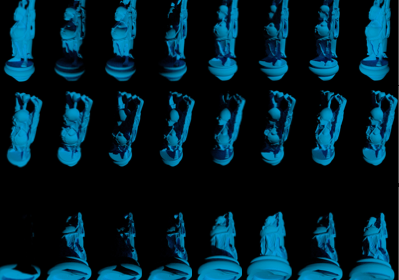LIGHT AND REFLECTANCE FIELDS
CG2010
Image based
rendering (IBR) techniques use images (precomputed or captured) of a
scene or object to generate new views of the scene or object without the
knowledge of its geometry. IBR techniques try to extract a slice of the
6D BRDF to approximate the surface behaviour from a new view point
(e.g. Light Fields) or new illumination conditions(e.g. Reflectance
FIelds). Due to the lack of geometry the process of generating a new
image is greatly simplify and is independent of the scene complexity.
Light Fields [1][2][3][4] are able to
extract a 4D slice of surface (scene or object) by dropping the light
dependent phenomena, which leads to the lack of ability to generate new
images with different illumination than the recorded on the samples.
On the other hand reflectance fields
[5][6][7] are able to generate new illumination scenarios but lack the
ability to change view point since the goal is met by dropping the view
dependency.
The goal of this project was two combine the two techniques in single viewer to allow the generation of new images from arbitrary position and light conditions.
Light and Reflectance Fields
[1]Levoy, M. and Hanrahan,
P. 1996. Light field rendering. In Proceedings of the 23rd Annual
Conference on Computer Graphics and interactive Techniques SIGGRAPH '96.
ACM, New York, NY, 31-42.
http://doi.acm.org/10.1145/237170.237199
[2] Isaksen, A., McMillan,
L., and Gortler, S. J. 2000. Dynamically reparameterized light fields.
In Proceedings of the 27th Annual Conference on Computer Graphics and
interactive Techniques International Conference on Computer Graphics and
Interactive Techniques. ACM Press/Addison-Wesley Publishing Co., New
York, NY, 297-306. http://doi.acm.org/10.1145/344779.344929
[3] E. Camahort, A.
Lerios, and D. Fussell, "Uniformly sampled light fields," in 9th
Eurographics Workshop on Rendering, (Vienna, Austria), pp. 117-130,
June/July 1998.
[4] Gortler, S. J.,
Grzeszczuk, R., Szeliski, R., and Cohen, M. F. 1996. The lumigraph. In
Proceedings of the 23rd Annual Conference on Computer Graphics and
interactive Techniques SIGGRAPH '96. ACM, New York, NY, 43-54.
http://doi.acm.org/10.1145/237170.237200
[5] Malzbender, T., Gelb, D.,
and Wolters, H. 2001. Polynomial texture maps. In Proceedings of the
28th Annual Conference on Computer Graphics and interactive Techniques
SIGGRAPH '01. ACM, New York, NY, 519-528. DOI= http://doi.acm.org/10.1145/383259.383320
[6 ]Wood, D. N., Azuma, D.
I., Aldinger, K., Curless, B., Duchamp, T., Salesin, D. H., and
Stuetzle, W. 2000. Surface light fields for 3D photography. In
Proceedings of the 27th Annual Conference on Computer Graphics and
interactive Techniques International Conference on Computer Graphics and
Interactive Techniques. ACM Press/Addison-Wesley Publishing Co., New
York, NY, 287-296. DOI= http://doi.acm.org/10.1145/344779.344925
[7] Jan Meseth, Gero Müller, and Reinhard Klein. Reflectance field based real-time, high-quality rendering of bidirectional texture functions. Computers and Graphics, 28(1):103–112, February 2004









